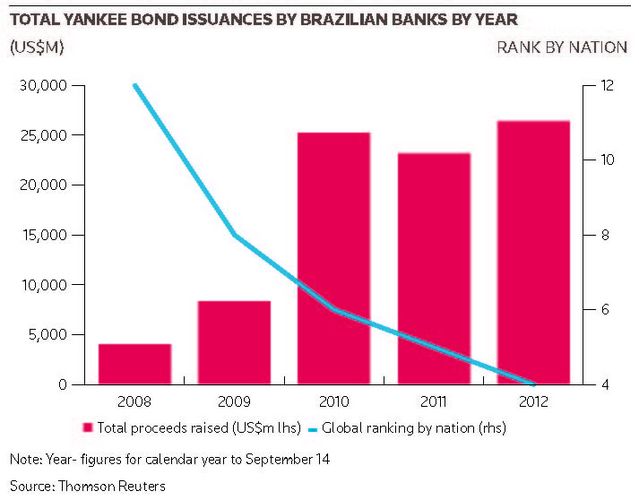For months – indeed, for most of the year – eurozone banks had been frozen out of the US. Then ECB President Mario Draghi’s words allowed the ice to thaw, cracking open the door to Europe’s leading lenders.
To view the digital version of this report, please click here.
A picture may tell a thousand words, but sometimes just a few words can sell a thousand bonds.
European Central Bank President Mario Draghi’s vow to do “whatever it takes” to save the single currency, up to and including purchasing all eurozone countries’ short-term bonds – the latter pledge made on September 6 – may be the best thing the ECB president ever does.
Overnight it lifted all boats, giving the markets a much-needed late summer fillip, boosting equities and putting the spring back in the bond market. But perhaps nowhere were the effects of Draghi’s magic more keenly and immediately felt than in the Yankee bond market.
France’s BNP Paribas was the first to test the waters. After seeing spreads on its 2016 bonds tighten, it launched a US$1.25bn five-year issuance, its first Yankee bond in 16 months. Nor was France’s largest lender by assets inclined to give investors a free lunch after such a long absence. It broke out of the gate with initial guidance of 185bp–190bp before tightening to guidance of 180bp and issuing at 178bp.
Returning the love
Investors, as if recognising the return of an old flame from war, returned the love. The self-led deal garnered more than US$4bn of demand: a remarkable turnround in fortunes proving, if nothing else, that European lawmakers were sometimes capable of doing the simple things (saying and then doing things the market likes) quite well.
Yet despite its success, BNP Paribas’ deal at first appeared to float alone, making investors question whether it was a marker, or a one-hit ’eurowonder’. Rather than presaging an expected American stampede, many European lenders seemed to hold back, or pursue alternative capital-raising routes. Danske Bank and ABN AMRO both opted to turn to the Asian Reg S dollar market in search of fresh funding.
Eventually, though, others were tempted. Nordea, a favourite among American investors, who consider it the cream of the Nordic crop, tapped the US dollar market on September 17 for the first time since January, just when the swap currency environment was improving. Its 10-year bullet trade, raising US$1bn on triple that amount of orders, was the first of its kind issued since May 2011.
Questions do still hang over European Yankee deals. Lower-end lenders, particularly those from peripheral European markets, may still struggle to gain traction in the US.
But for the continent’s blue-chip names, the money is there if it is needed, syndicates said. Gordon Taylor, managing director, financial institutions DCM at RBS in London, describes the US market as a “very exciting market for European borrowers” now that the worst of the European crisis appears – for now at least – to be consigned to the past.
Tom Criqui, head of FIG syndicate at Deutsche Bank in New York, credits the BNPP trade with opening up the market again to European issuers, while boosting liquidity.
“That trade [was] good, and my sense is that you might see some follow-up with other banks looking at the market now,” he said. “The last major deal was Handelsbanken in March, so to see a French bank of a considerable size [tapping the market] was a very good sign.”
Europe’s banks, many still humbled and hobbled by the continent’s sovereign debt crisis, which, lest we forget, is still a going concern, are hardly top dog in the Yankee world, for all of Draghi’s soothing words.
Top billing this year goes to Britain’s hungry banks, which together issued US$60bn worth of new paper to US investors in the year to September 14, according to Thomson Reuters.
Royal Bank of Scotland, piggybacking on BNPP’s momentum, was beaming broadly after announcing tenders for nine of its dollar-denominated bonds worth US$13.25bn – part of a larger £16.6bn liability management buyback scheme. That marked the British bank’s first Yankee issuance in more than 18 months.
Two more Anglo-Saxon markets followed the UK in quick succession. Canada’s expansion-oriented banks issued US$49.4bn worth of Yankees, followed by Australian lenders in third place at US$36.2bn. That figure nearly trumped the combined issuance of French, German and Dutch lenders, which raised a combined total of US$36.9bn over the period.
Australia and US love affair
For its part, Australia has remained a nailed-on favourite among US investors throughout the European sovereign debt crisis. An Aussie lender only has to whisper “Yankee” to be inundated by orders from the other side of the Pacific.
The love affair between Australia and America is mutually charged. The US 144a market remains hugely attractive to Australian market in large part because, RBS’s Taylor says, the “domestic Aussie market doesn’t satisfy all their [bank] funding requirements”.
US investors in turn love the stability and consistency offered by a stable of rock-solid lenders operating in an English-speaking market far removed from Europe’s intermittent meltdown. “US investors have Aussie [banks] at the top of their pick list at the moment,” said Taylor.
This view is clearly borne out by statistics. Each of Australia’s four banking pillars issued at least one set of US bonds in the year to September 14, with activity focused on the three to five-year parts of the curve.
Commonwealth Bank of Australia led the charge, inundating investors with US$4bn in new paper in March: US$2bn in three-year senior unsecured notes at 1.963%, and US$2bn of privately placed five-year covered bonds at 2.265%, 1.406 points over Treasuries. In September it repeated the trick, raising US$3.25bn from a mixture of senior unsecured notes and medium-term floating notes.
ANZ, Westpac and National Australia Bank have also happily tapped the American market. NAB was welcomed with open arms in March, issuing US$2.5bn in new paper that dragged in US$6.75bn in orders. ANZ, which endured a torrid US debut last November, fared better in September, raising US$2.25bn from a brace of short-dated 2015 issuances, and US$750m from five-year senior unsecured notes.
A measure of the comfort US investors feel about Australia’s finest is measured by the regularity with which the latter taps the former for cash, and the scale of the average sale. Six of the 11 largest Yankee bond sales completed in the year to September 14 were launched by banks headquartered in either Melbourne or Sydney.
“Australia’s ability to perform consistently well, despite all that Europe has thrown at the markets, is significant,” said one London-based syndicate manager. “US investors feel secure putting their dollars to work there.”
Rising star
Brazil is another, more quietly rising star. The southern hemisphere’s largest economy now supports a group of lenders as healthy as any in the developed, let alone the developing, world. Three of these – Itau Unibanco, Bradesco, and Banco de Brasil – issued hefty Yankee bonds in the year to September 14.
And look at the year by years. Brazil was the 12th largest sovereign issuer of Yankee bonds in the year to September 14 2008. The following year its banks upped their issuance, pushing Brazil up to eighth. Each year it has inched up a notch, finally reaching fourth in the current year to September 14, a period in which Brazilian banks issued US$26.32bn worth of new US bonds, a record for the country.
Looking ahead, said Deutsche Bank’s Criqui, the market looks “on a good course”. US investors are enjoying, relative to recent years, a feast of options. Brazil’s star is rising; Europe’s faded one is being hurriedly reshined; Australia remains steady as a rock. Criqui said the ability of the ECB and its decisive president had made all the difference. “A few big investors suddenly got back into the market, in part because they realised that central banks were [prepared to] backstop [it].”
The good times aren’t back – yet. Europe remains a thorn in everyone’s side and while US investors have accepted a few lenders back into the fold, their embrace is guarded and reserved for a few, top-tier names.
Europe indeed may stumble again in the months ahead – the old continent has got awfully good at tripping over its old feet – but many banks and syndicates haven’t had it this good in years, and all because of Mario Draghi and his ability to paint by numbers.

